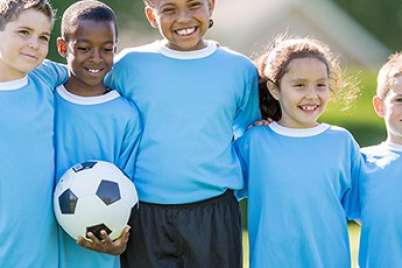
How to help your child master movement skills in the air
As the weather gets warmer this time of year, you may find you have an extra spring in your step. This desire to leap and move around in the sunshine is a good time for the final installment of our four-part environmental series: building physical literacy in the air. As we did previously with water, land, and snow and ice, we’ll take a look at mastering the fundamental movement skills in a different setting, this time while airborne.
Why it’s important to master physical literacy in the air
Learning how to move in the air is about taking your skills to another level – literally – by adding momentum to the skills already mastered on land. If you can run, hop, throw, jump up and down, and balance your body in various ways, then you can learn to project your body, such as jumping high or far, or twirling or flipping in the air. By mastering hopping, jumping and leaping, other sport skills eventually become possible, including:
- Athletics: long-jump, high-jump, pole-vaulting, hurdles
- Gymnastics
- Dance
- Volleyball jumps
- Basketball lay-up
- Touchdown leaps
- Jumping and twirling while skiing or skating
- Diving into water
- And so much more!
Airborne skills also help build better body awareness and overall confidence in movement.
Getting started
Before you can jump right into all those activities, it’s necessary to start with the basic skills. And it’s never too early to learn.
Hop/Jump
Young children with their boundless energy seem to hop around almost intuitively. But jumping is actually a learned skill that a lot of kids don’t figure out or master until they’re around two years old. It takes practice and there are ways to encourage it. Play games like leapfrog or hopscotch. Older kids can skip. Once the basic up-and-down movement is learned, you can encourage “flight” by having them jump off something with height, like a step, bench, rock, or by bouncing on a trampoline.
Leap
Leaping is the next level in jumping. It’s adding speed and forward momentum to the up-and-down movement. Leaping is the motion of running, then jumping by kicking one foot forward and one foot back. This skill can easily be practiced on the lawn or at a park. Make it fun by jumping over something, like a skipping rope, ball, or any other equipment you have handy. You can also practice jumping from alternating feet, or going sideways, backwards, and forward.
Swing
Airborne skills aren’t just about jumping off the ground; it’s also about body movement in the air, like swinging. All you need is some good old-fashioned fun at a playground. Kids can hang and swing from the monkey bars, or see how high they can pump themselves on a swing and even jump off, if feeling brave. Playing on rope swings and ziplines also help foster confidence and body awareness while moving through the air.
Spin/Flip
These are the most advanced airborne moves that take longer to master. And to be fair, spinning or flipping upside down in the air is not going to be fun for everyone. But for the adventurous child it is the next step in body movement and awareness.
A somersault or cartwheel is the best place to start as it gets your child used to propelling themselves forward and upside down. With guidance, children can practice these skills on a lawn or in a gym. A gymnastics class will help those who want to push these skills even further and become more airborne with their flips. Likewise, swimming lessons are a great way to learn and practice these skills. Diving and jumping into the water is a fun activity to get some air.
When kids learn to master these fundamental movement skills in the air, it opens up so many options for sport and activity. Jumping and leaping are so integral to sport it’s essential to hop-to-it from the get-go!





